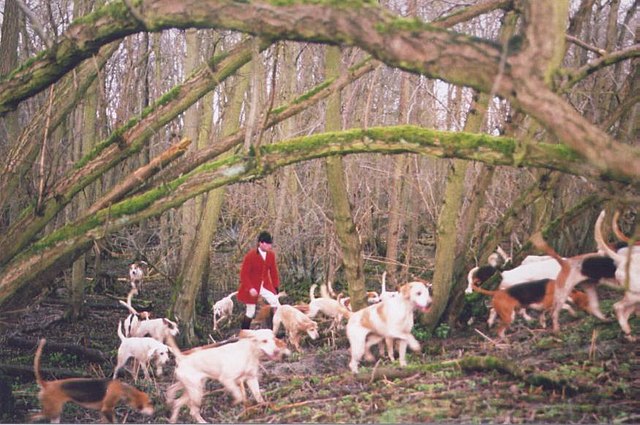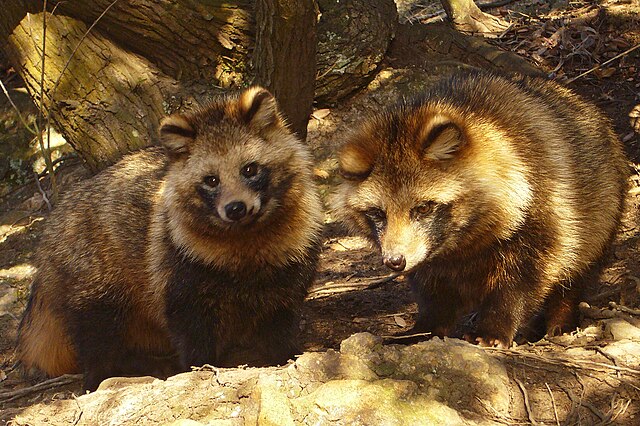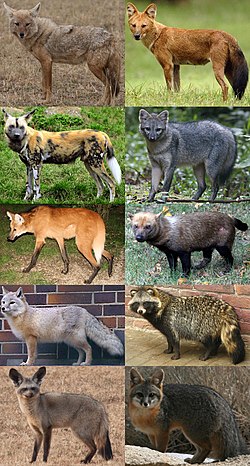കാനിഡേ
From Wikipedia, the free encyclopedia
Remove ads
നായകളും, ചെന്നായകളും, കൊയോട്ടികളും, കുറുക്കനും, കുറുനരിയും, ഡിങ്കോകളും കൂടാതെ നിരവധി നിലവിലുള്ളതും വംശനാശം സംഭവിച്ചതുമായ, നായകളെപ്പോലെയിരിക്കുന്ന സസ്തനികൾ അടങ്ങിയ ഒരു കുടുംബമാണ് കാനിഡേ (Canidae) /ˈkænɪdiː/ [3] (ലാറ്റിനിൽ കാനിസ് എന്നാൽ നായ എന്നർത്ഥം). ഈ കുടുംബത്തിലെ അംഗങ്ങളെ കാനിഡ് (canid) (/ˈkænɪd/, /ˈkeɪnɪd/) എന്നു വിളിക്കുന്നു.[4]
Remove ads
നാമകരണം
ഫൈലോജനിൿ ബന്ധങ്ങൾ

കാനിഡേയ്ക്കുള്ളിൽ, അലോസൈം, ക്രോമസോം വിശകലനങ്ങളുടെ ഫലങ്ങൾ മുമ്പ് നിരവധി ഫൈലോജെനെറ്റിക് ഡിവിഷനുകൾ നിർദ്ദേശിച്ചിട്ടുണ്ട്:
- The wolf-like canids (genus Canis, Cuon, and Lycaon) include the domestic dog (Canis lupus familiaris), gray wolf (Canis lupus), red wolf (Canis rufus), eastern wolf (Canis lycaon), coyote (Canis latrans), Eurasian golden jackal (Canis aureus), African golden wolf (Canis anthus), Ethiopian wolf (Canis simensis), black-backed jackal (Canis mesomelas), side-striped jackal (Canis adustus), dhole (Cuon alpinus), and African wild dog (Lycaon pictus).[5]
- The fox-like canids include the kit fox (Vulpes velox), red fox (Vulpes vulpes), Cape fox (Vulpes chama), Arctic fox (Vulpes lagopus), and fennec fox (Vulpes zerda).[5]
- The South American canids include the bush dog (Speothos venaticus), hoary fox (Lycalopex uetulus), crab-eating fox (Cerdocyon thous), and maned wolf (Chrysocyon brachyurus).[5]
- Various monotypic taxa include the bat-eared fox (Otocyon megalotis), gray fox (Urocyon cinereoargenteus), and raccoon dog (Nyctereutes procyonoides).[5]
DNA analysis shows that the first three form monophyletic clades. The wolf-like canids and the South American canids together form the tribe Canini.[6] Molecular data imply a North American origin of living Canidae some 10 Mya and an African origin of wolf-like canines (Canis, Cuon, and Lycaon), with the jackals being the most basal of this group. The South American clade is rooted by the maned wolf and bush dog, and the fox-like canids by the fennec fox and Blanford's fox. The gray fox and island fox are basal to the other clades; however, this topological difference is not strongly supported.[7]
The cladogram below is based on the phylogeny of Lindblad-Toh et al. (2005),[7] modified to incorporate recent findings on Canis,[8] Vulpes,[9] Lycalopex,[10] and Dusicyon[11] species.
| Canidae |
| |||||||||||||||||||||||||||||||||||||||||||||||||||||||||||||||||||||||||||||||||||||||||||||||||||||||||||||||||||||||||||||||||||||||||||||||||||||||||||||||||||||||||||||||||||||||||||||||||||||||||
Remove ads
പരിണാമം

Life history


നിലവിലുള്ളതും സമീപകാലത്ത് വംശനാശം സംഭവിച്ച സ്പീഷിസുകളും











All extant species of family Canidae are in subfamily Caninae.
Subfamily Caninae
- True dogs – Tribe Canini
- Genus Canis (see also List of Canis species and subspecies which also includes some varieties)
- Gray wolf, Canis lupus (2.723 Mya to present)
- Domestic dog, Canis lupus familiaris
- Dingo, most often classified as Canis lupus dingo
- Many other subspecies
- Red wolf, Canis rufus (sometimes considered a subspecies of the gray wolf, but including several subtaxa of its own, including the Florida black wolf)
- Eastern wolf, Canis lycaon
- Coyote, Canis latrans (also called prairie wolf and brush wolf)
- Dire wolf, Canis dirus (0.25 mya) †
- African golden wolf, Canis anthus
- Golden jackal, Canis aureus
- Ethiopian wolf, Canis simensis (also called Abyssinian red jackal, Simien fox and Simien jackal)
- Side-striped jackal, Canis adustus
- Black-backed jackal, Canis mesomelas (also called silver-backed jackal)
- Gray wolf, Canis lupus (2.723 Mya to present)
- Genus Cuon
- Dhole, Cuon alpinus or Canis alpinus (also called Asiatic wild dog)
- Genus Cynotherium †
- Sardinian dhole, Cynotherium sardous †
- Genus Lycaon
- African wild dog, Lycaon pictus (also called African hunting dog)
- Genus Atelocynus
- Short-eared dog, Atelocynus microtis
- Genus Cerdocyon
- Crab-eating fox, Cerdocyon thous
- Genus Dusicyon †
- Genus Lycalopex (Pseudalopex)
- Culpeo, Lycalopex culpaeus
- Fuegian dog, Lycalopex culpaeus domesticus †
- Darwin's fox, Lycalopex fulvipes
- South American gray fox, Lycalopex griseus
- Pampas fox, Lycalopex gymnocercus
- Sechuran fox, Lycalopex sechurae
- Hoary fox, Lycalopex vetulus
- Culpeo, Lycalopex culpaeus
- Genus Chrysocyon
- Maned wolf, Chrysocyon brachyurus
- Genus Speothos
- Bush dog, Speothos venaticus
- Genus Canis (see also List of Canis species and subspecies which also includes some varieties)
- True foxes – Tribe Vulpini
- Genus Vulpes
- Arctic fox, Vulpes lagopus
- Red fox, Vulpes vulpes (1 Mya to present)
- Domesticated red fox, Vulpes vulpes amicus
- Swift fox, Vulpes velox
- Kit fox, Vulpes macrotis
- Corsac fox, Vulpes corsac
- Cape fox, Vulpes chama
- Pale fox, Vulpes pallida
- Bengal fox, Vulpes bengalensis
- Tibetan sand fox, Vulpes ferrilata
- Blanford's fox, Vulpes cana
- Rüppell's fox, Vulpes rueppelli
- Fennec fox, Vulpes zerda
- Genus Nyctereutes
- Raccoon dog, Nyctereutes procyonoides
- Genus Otocyon
- Bat-eared fox, Otocyon megalotis
- Genus Vulpes
- Genus Urocyon (2 Mya to present)
- Gray fox, Urocyon cinereoargenteus
- Island fox, Urocyon littoralis
- Cozumel fox, Urocyon sp.

Remove ads
Prehistoric Canidae
Except where otherwise stated, the following classification is based on a 1994 paper by Xiaoming Wang, curator of terrestrial mammals at the Natural History Museum of Los Angeles County on the systematics of the subfamily Hesperocyoninae,[12] a 1999 paper by Wang, together with the zoologists Richard H. Tedford and Beryl E. Taylor on the subfamily Borophaginae,[13] and a 2009 paper by Tedford, Wang and Taylor on the North American fossil Caninae.[14]
Subfamily Caninae



- Genus Cynodictis
- Genus Gobicyon
- Genus Protemnocyon
- Tribe Canini[14]
- Genus Canis
- Canis adoxus †
- Canis ameghinoi †
- Canis apolloniensis (1.1 Mya) †
- Canis armbrusteri (1.5 Mya) †
- Canis arnensis (1.9-1.6 Mya) †
- Canis cautleyi †
- Canis cedazoensis (4.6 Mya) †
- Canis dirus (0.125-0.009 Mya)†
- Canis donnezani (4.0–3.1 Mya) †
- Canis edwardii (4.6 Mya) †
- Canis (Eucyon) cipio (8.2 Mya) †
- Canis etruscus (1.9-1.6 Mya) †
- Canis ferox (5 Mya) †
- Canis gezi †
- Canis lepophagus (8 Mya)†
- Canis michauxi †
- Canis othmani †
- Canis mosbachensis (0.5 Mya) †
- Canis nehringi †
- Canis variabilis (0.5 Mya) †
- Genus Theriodictis (1.19 Mya)†
- Genus Protocyon †
- Genus Cerdocyon
- Genus Speothos
- Speothos pacivorus †
- Genus Nurocyon †
- Nurocyon chonokhariensis †
- Genus Xenocyon †
- Genus Canis
- Tribe Vulpini
- Basal Caninae
- First Caninae
Subfamily Borophaginae
- Genus Archaeocyon (7 Mya) †
- Genus Otarocyon (7.6 Mya) †
- Genus Oxetocyon (2.5 Mya) †
- Genus Rhizocyon (30 Mya)
- Rhizocyon oregonensis (30 Mya)
- Tribe Phlaocyonini (27.2 Mya) †
- Genus Cynarctoides (16.7 Mya) †
- Genus Phlaocyon (30–19 Mya)
- Phlaocyon achoros
- Phlaocyon annectens (22 Mya)
- Phlaocyon latidens (30 Mya)
- Phlaocyon leucosteus (22 Mya)
- Phlaocyon mariae
- Phlaocyon marslandensis (19 Mya)
- Phlaocyon minor (30 Mya)
- Phlaocyon multicuspus
- Phlaocyon taylori[15]
- Phlaocyon yakolai (19 Mya)
- Tribe Borophagini (16.7 Mya) †
- Genus Cormocyon (10.2 Mya) †
- Genus Desmocyon (9 Mya) †
- Genus Metatomarctus (4.3 Mya) †
- Genus Euoplocyon (18–16 Mya)
- Euoplocyon brachygnathus (16 Mya)
- Euoplocyon spissidens (18 Mya)
- Genus Psalidocyon (16 Mya)
- Psalidocyon marianae (16 Mya)
- Genus Microtomarctus (4 Mya) †
- Genus Protomarctus (18 Mya)
- Protomarctus optatus (18 Mya)
- Genus Tephrocyon (16 Mya)
- Tephrocyon rurestris (16 Mya)
- Subtribe Cynarctina †
- Subtribe Aelurodontina (15 Mya) †
- Subtribe Borophagina (17 Mya) †
Subfamily Hesperocyoninae
† (Mya = million years ago)
- Genus Cynodesmus (32–29 Mya)
- Cynodesmus martini (29 Mya)
- Cynodesmus thooides (32 Mya)
- ?Genus Caedocyon
- Caedocyon tedfordi
- Genus Ectopocynus (32–19 Mya)
- Ectopocynus antiquus (32 Mya)
- Ectopocynus intermedius (29 Mya)
- Ectopocynus siplicidens (19 Mya)
- Genus Enhydrocyon (29–25 Mya)
- Enhydrocyon basilatus (25 Mya)
- Enhydrocyon crassidens (25 Mya)
- Enhydrocyon pahinsintewkpa (29 Mya)
- Enhydrocyon stenocephalus (29 Mya)
- Genus Hesperocyon (39.74–34 Mya)
- Hesperocyon coloradensis
- Hesperocyon gregarius (37 Mya)
- Genus Mesocyon (34–29 Mya)
- Mesocyon brachyops (29 Mya)
- Mesocyon coryphaeus (29 Mya)
- Mesocyn temnodon
- Genus Osbornodon (32–18 Mya)
- Genus Paraenhydrocyon (30–25 Mya)
- Paraenhydrocyon josephi (30 Mya)
- Paraenhydrocyon robustus (25 Mya)
- Genus Philotrox (29 Mya)
- Philotrox condoni (29 Mya)
- Genus Prohesperocyon (36 Mya)
- Prohesperocyon wilsoni (36 Mya)
- Genus Sunkahetanka (29 Mya)
- Sunkahetanka geringensis (29 Mya)
Remove ads
ഇവയും കാണുക
- Canid hybrid
- Free-ranging dog
അവലംബം
External links
Wikiwand - on
Seamless Wikipedia browsing. On steroids.
Remove ads





